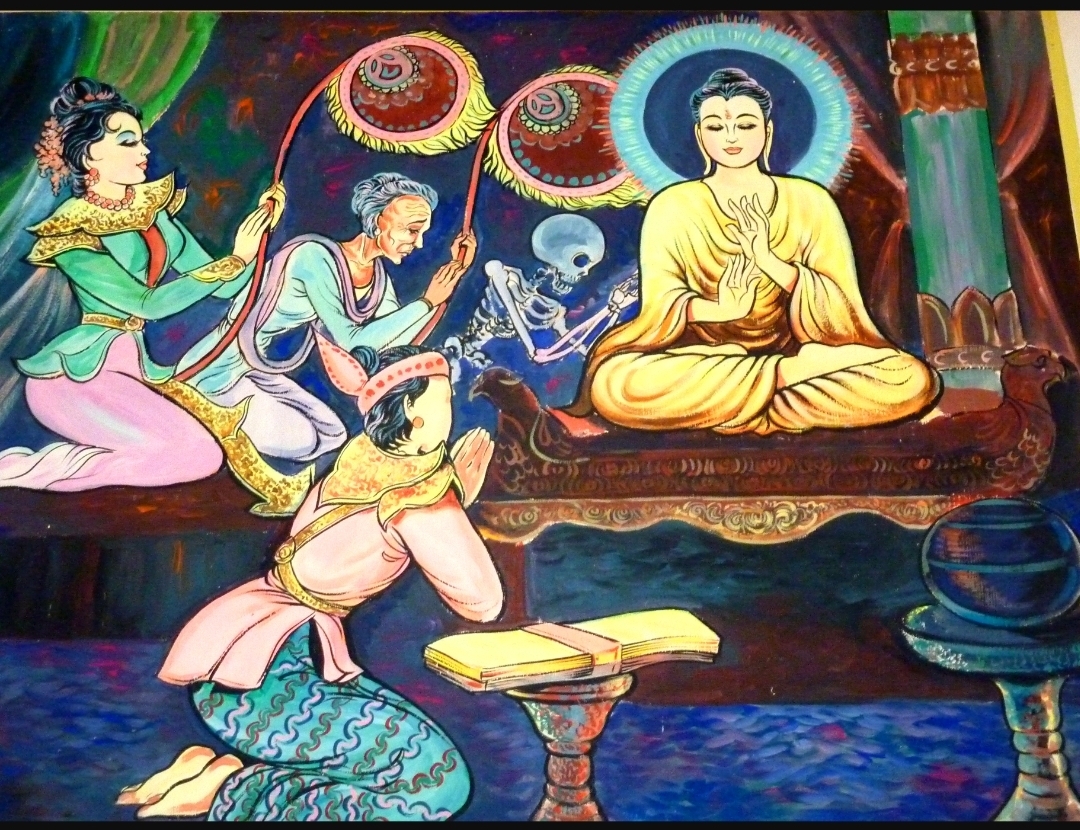The Three Marks Of Existence: An Introduction & Analysis
The Tilakkhana, or the Three Marks of Existence—namely, anicca (impermamance), dukkha (suffering/unsatisfactoriness), and anatta (no self)—describe the ultimate reality of all phenomena and beings—whether animate or animate—in Buddhism. Misgivings about the three marks (or, in certain translations, characteristics) constitites avidya (delusion) and leads to feelings of unsatisfactoriness and the seemingly never-ending cycle of birth and death. The essence of the Buddha's teachings lies in the realization of the Tilakhhana, which the Realized One claims leads to the cessation of suffering, and consquently nirvana.
But what exactly are these marks? What is it that makes them so different from extant ontological theories?
1. Anicca (Impermanence)
(A Buddhist painting depicting impermanence. Credit goes to the original author.)
The flow of the river never ceases,
And the water never stays the same.
Bubbles float on the surface of pools,
Bursting, re-forming, never lingering.
They’re like the people in this world and their dwellings.
Whatever has come into existence shall invariably cease to be. Seeds sprout, become trees, and decay from within; flowers that blossom gaily in the morning are seen withering away in the night; stars, the Sun, the Moon and the planets rise and set everyday—there is nothing that can claim itself to be permanent in the Universe. Wealth, stealth, fame and lust—these come and go. Your loved ones, to whom you are attached as firmly as a monkey cub is to its mother, shall be turned into ashes some day.
The Buddhist doctrine of impermanence, in addition to being what causes dukkha to arise, rejects two foundational metaphysical Vedic concepts—atman and Brahman. While Buddha did not reject the existence of Vedic deities, the idea of a Creator God, or an indestructible, immutable, all-encompassing entity, was foreign to the tenets of Buddhism.
(It is important to note here that Buddhist theology is pretty similar to its Hindu counterpart. Devas have longer lifespans, possess psychic abilities (sometimes even the ability to control the elements), and reside in a higher plane than ordinary humans and the demigods. What is even more interesting is that the Buddha repeteadly says that he does not deny the efficacy of Vedic sacrifices insofar as they claim that those who perform them shall be reborn in heaven; what he refutes is the belief that these gods are immortal and that praying to them will lead to enlightenment and nirvana.)
In the Brahma-Nimantanika Sutta, the Tathagata relates to his disciples an encounter with Baka, a Brahma—
On one occasion recently I was staying in Ukkaṭṭha in the Subhaga forest at the root of a royal Sal tree. Now on that occasion an evil viewpoint had arisen to Baka Brahmā: ‘This is constant. This is permanent. This is eternal. This is total. This is not subject to falling away—for this does not take birth, does not age, does not die, does not fall away, does not reappear.And there is no other, higher escape.’
(Source: Thanissaro Bhikkhu's translation of the Majjhima Nikaya.)
Impermanence, in my humble opinion, directly leads to one of the most profound (and original) theories of Buddhism—anatta.
2. Anatta (No-Self/Not Self)
One thing that distinguishes Buddhism from contemporaneous religions and philosophical schools is its unambiguous rejection of any and all conceptions of a self. In fact, clinging to the idea of a self, whether permanent or impermanent, constitutes avidya and causes suffering.
The basis of the anatta doctrine is impermanece—in the Pali Canon, the Buddha argues that neither the corporeal (water, fire and so on) nor the incorporeal elements constitute self, because they are subject to a constant state of flux. What naturally follows is that the soul does not exist.
There does exist some dispute, however. While the refutation of a permanent self does not, in itself, raise eyebrows, the Buddhist belief in rebirth does. A valid question many Vedanta adherents pose is—if there is no soul whatsoever, what is it that reincarnates?
When confronted with this absurdity in the Buddhist teachings, lay practitioners and monks resort to three responses (neither sound satisfactory). The first one dismisses such metaphysical speculations as irrelevant to monastic life, the second posits that the Buddha rejected the existence of a permanent "self", and the third claims that it is consciousness that transmigrates. There seems to be a fourth answer—"spirit".
The first response doesn't really answer the question; the second is incorrect (see Brahmajala Sutta); the third is wholly refuted by the Buddha himself in the Majjhima Nikaya.
Anatta—and the closely related sunyata (which I fail to understand despite having studied Buddhism religiously for the last three years) —remains one of the most perceptive teaching Buddhism has to offer.
3. Dukhha (Suffering/Unsatisfactoriness).
What is dukkha? In The Turning Of The Wheel Of Law, the Buddha answers succinctly—
Rebirth is suffering; old age is suffering; illness is suffering; death is suffering; association with the disliked is suffering; separation from the liked is suffering; not getting what you wish for is suffering. In brief, the five grasping aggregates are suffering.
(SuttaCentral; Bhikkhu Sujato.)
Buddhism asserts that dolour characterises existence. Does this mean that it is nihilistic or, as Nietzsche claims, escapist?
Buddhism does say that rebirth is suffering, but it does not say that dukkha cannot be overturned. The Noble Eightfold Path is how one overcomes dukkha. Understanding non-self and impermanence is how one overcomes dukkha.
Moreover, nihilism is a philosophy that rejects all philosophical and moral framework. This contrasts with Buddhism, which comes with an extensive ethical framework. How can Buddhism be nihilistic?
All in all, if someone asks me what Buddhist philosophy is all about, I will simply say, "Realising Tilakkhana."

Comments
Post a Comment